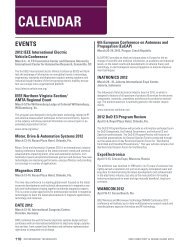Simple Method for Predicting a Cable Shielding Factor, Based on ...
Simple Method for Predicting a Cable Shielding Factor, Based on ...
Simple Method for Predicting a Cable Shielding Factor, Based on ...
Create successful ePaper yourself
Turn your PDF publications into a flip-book with our unique Google optimized e-Paper software.
S impl e Me t h o d f o r Predic t ing a c a bl e Shi e l ding Fa c t o r / M a rdigui a n<br />
shielding<br />
Figure 4. Calculated results <str<strong>on</strong>g>for</str<strong>on</strong>g> a 5m l<strong>on</strong>g single braid coaxial.<br />
First λ’/2 res<strong>on</strong>ance is reached around 20MHz.<br />
Figure 3. C<strong>on</strong>ceptual view of the Kr behavior above res<strong>on</strong>ance. Even<br />
with a good quality shield, the periodic shield current humps at odd<br />
multiples λ’/2 account <str<strong>on</strong>g>for</str<strong>on</strong>g> a typical 10dB deteriorati<strong>on</strong> of Kr<br />
worst case Kr above res<strong>on</strong>ance:<br />
Kr (min) = Vd max / Vcm<br />
= ( 0.7 Lt . Vcm / 210) / Vcm<br />
Kr min (dB) = - 20 Log [ 210 / 0.7 Lt(nH/m) ]<br />
Kr min (dB) = - 20 Log [ 300 / Lt(nH/m) ] (6)<br />
A Few Practical Results <str<strong>on</strong>g>for</str<strong>on</strong>g> Kr, below<br />
and above first cable res<strong>on</strong>ance<br />
The following figures show some calculati<strong>on</strong>s using<br />
the <str<strong>on</strong>g>for</str<strong>on</strong>g>mulas of this article, and test results.<br />
Figure 4 shows calculated results <strong>on</strong> a 5m l<strong>on</strong>g good<br />
quality single braid coaxial cable, 1 meter above ground,<br />
with perfect 360° c<strong>on</strong>tact at c<strong>on</strong>nector backshell. On<br />
Figure 5, the curve shows the test results of a 5m coaxial<br />
cable where the shield has been is intenti<strong>on</strong>ally spoiled<br />
by a 10cm pigtail. The deteriorati<strong>on</strong> of Kr above 8 MHz<br />
is spectacular.<br />
Appendix<br />
We have seen that when dimensi<strong>on</strong> of the cable approaches,<br />
or exceeds a half-wave length, the current <strong>on</strong> the shield follows<br />
a sinusoidal distributi<strong>on</strong> with alternating phase reversals<br />
every λ/2 segment. This is complicated by the fact that, if<br />
the test set-up is based <strong>on</strong> a 50Ω generator driving <strong>on</strong>e end of<br />
the shield, this latter appears as a transmissi<strong>on</strong> line shorted<br />
at the other end, subject to standing waves. This mismatch<br />
causes nulls and peaks of current at every multiple of λ/4.<br />
For the odd multiples like λ/4, 3 λ/4, 5λ/4 … etc., the<br />
null of current corresp<strong>on</strong>d to the generator seeing an infinite<br />
impedance. While the driving voltage is equal to the<br />
open-circuit value, the current minimum <strong>on</strong> the shield<br />
is causing a drop in the terminal voltage Vd, there<str<strong>on</strong>g>for</str<strong>on</strong>g>e the<br />
value of Kr artificially jumps to higher values. This effect is<br />
Figure 5. Kr <str<strong>on</strong>g>for</str<strong>on</strong>g> a 5m coaxial, shield grounded with 10cm pigtail<br />
(courtesy of AEMC Grenoble, France ).<br />
Figure 6. Kr <str<strong>on</strong>g>for</str<strong>on</strong>g> 5m shielded computer cable, with good quality<br />
SubD25 shielded c<strong>on</strong>nector (courtesy AEMC Grenoble, France)<br />
4 interference technology emc Directory & design guide 2012




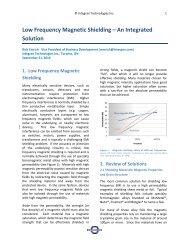

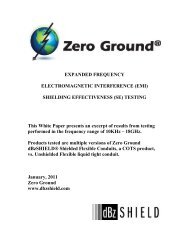


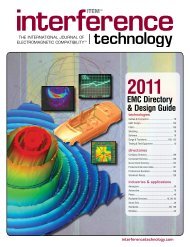

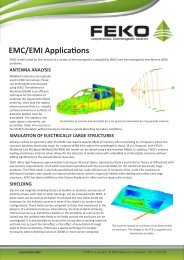
![[ thursday ] morning sessions 8:30 am-noon - Interference Technology](https://img.yumpu.com/23176841/1/190x247/-thursday-morning-sessions-830-am-noon-interference-technology.jpg?quality=85)
